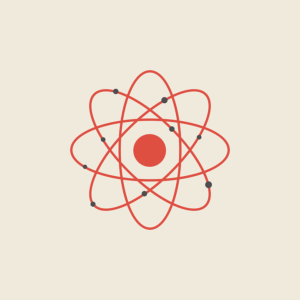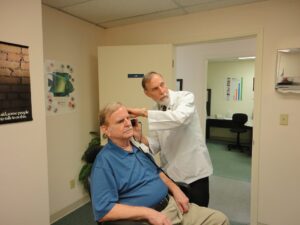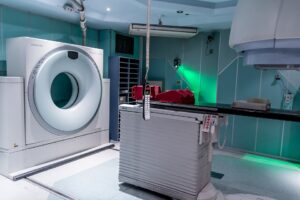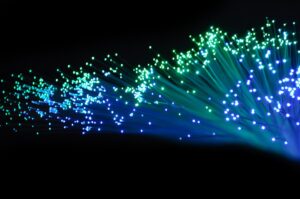 Fiber Bragg grating (FBG) can be used as miniature, inexpensive, and lightweight strain, temperature, and pressure sensors for applications such as real-time health monitoring of aircraft, space vehicles, and smart materials and structures. Nowadays only a few applications of FBGs in chemical sensing have been reported.
Fiber Bragg grating (FBG) can be used as miniature, inexpensive, and lightweight strain, temperature, and pressure sensors for applications such as real-time health monitoring of aircraft, space vehicles, and smart materials and structures. Nowadays only a few applications of FBGs in chemical sensing have been reported.
The key to a chemical sensor using an FBG lies in the transfer of stress from a swelling material, such as a polymer, to the FBG, resulting in a measurable strain via the shift in resonant Bragg wavelength.
The main principle of FBG sensors for applications in chemical sensing is based on the axial strain of the fiber. The chemicals that surround the fiber cause it to shift and, deform. The strain caused by the presence of a particular chemical causes the spectral pattern of reflected light to change; the shift in reflected wavelength is observed. To monitor the shift in wavelength FBG interrogators are used. The data gathered by the interrogator can then be converted to environmental concentrations.
The key component of fiber Bragg grating sensors for chemical sensing is a highly sensitive coating. The coating should be stiff and adhere easily and firmly to the glass fiber. Most often the coating is based on polymers. However, the coating needs to have a high modulus of elasticity that remains high at high temperatures and during analytes absorption. Most polymers are restricted by temperature due to softening and material relaxation.
Some ways of FBG sensors polymer coating include:
- improved coating processing;
The improvement of the coating process, like improved adhesion, may aid in the reduction of material relaxation and shifting. The glass fiber may be treated before the application of polymer coating for improved adhesion.
- improved data processing;
The use of two different coatings that respond in equal, but the opposite manner to environmental changes. The combination of the two responses limits the temperature drift.
- improved material properties.
Alternative coatings, like ones based on ceramic materials, may expand the temperature application range.
Chemical sensing is a developing field of fiber Bragg grating sensors. It is involved in the control of chemical processes, oil recovery, environment quality improvement. There are several factors that play a role in the implementation of chemical sensors – suitability for remote sensing, sensitivity, low costs, selectivity, ability to work consistently in harsh environments. The oil and gas applications require sensors that can withstand high temperatures and pressures, and environmental sensors must have a wide coverage area and limited signal fluctuations.
Fiber Bragg grating sensors have been used in numerous applications, including aircraft monitoring, structural health monitoring, strain, and temperature measurements. In the last decade, FBG sensors have been implemented as chemical sensors due to their ability to withstand high temperatures, immunity to electromagnetic interference, and the absence of electronics.
Optromix, Inc. is a U.S. manufacturer of innovative fiber optic products for the global market, based in Cambridge, MA. Our team always strives to provide the most technologically advanced fiber optic solutions for our clients. Our main goal is to deliver the best quality fiber optic products to our clients. We produce a wide range of fiber optic devices, including our cutting-edge customized fiber optic Bragg grating product line and fiber Bragg grating sensor systems. Optromix, Inc. is a top choice among the manufacturers of fiber Bragg grating monitoring systems. If you have any questions, please contact us at info@optromix.com




 A biocompatible and highly stretchable optical fiber made from hydrogel may be implanted in the body to deliver therapeutic pulses of light or light up at the first sign of disease. This hydrogel fiber was developed by researchers from MIT (Massachusetts Institute of Technology) and Harvard Medical School. Hydrogels have already shown significant potential in everything from wound dressings to soft robots, but until now their
A biocompatible and highly stretchable optical fiber made from hydrogel may be implanted in the body to deliver therapeutic pulses of light or light up at the first sign of disease. This hydrogel fiber was developed by researchers from MIT (Massachusetts Institute of Technology) and Harvard Medical School. Hydrogels have already shown significant potential in everything from wound dressings to soft robots, but until now their  Modern research allows creating more and more biocompatible and highly stretchable
Modern research allows creating more and more biocompatible and highly stretchable  Nowadays the production of optical fibers is robust and flexible enough to address an exciting new range of biomedical applications.
Nowadays the production of optical fibers is robust and flexible enough to address an exciting new range of biomedical applications.  Measurement of angular velocity is useful in many different applications, from missile navigation to motion control. There are three broad categories of possible sensors for angular velocity: Ring Laser Gyroscopes (RLG), Fiber Optic Gyroscopes (FOG), and MEMs-based Gyroscopes. The former two utilize the Sagnac effect to measure velocity and are much more sensitive compared to MEMs gyroscopes. A fiber optic gyroscope (FOG) is a device that senses changes in orientation using the Sagnac effect. Such a
Measurement of angular velocity is useful in many different applications, from missile navigation to motion control. There are three broad categories of possible sensors for angular velocity: Ring Laser Gyroscopes (RLG), Fiber Optic Gyroscopes (FOG), and MEMs-based Gyroscopes. The former two utilize the Sagnac effect to measure velocity and are much more sensitive compared to MEMs gyroscopes. A fiber optic gyroscope (FOG) is a device that senses changes in orientation using the Sagnac effect. Such a  The uses of
The uses of  Fiber optic products
Fiber optic products Fiber optic devices
Fiber optic devices